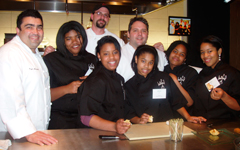Gathering Around the Table, the Brainfood Way
Although we encourage exploration and creativity in all of our Brainfood kitchens, our classes are designed with a consistent structure. Brainfood participants arrive knowing that the whiteboard displaying the day’s agenda can answer their often-foremost question (“What are we making today?”) as well as provide the order of events for our time together.
Each Brainfood class starts with an opening—a time for everyone in the room to welcome and check-in with one another, as well as designate an expectation/goal for themselves for the day. We then transition to a period of information sharing. This is a time for instructors to engage participants in a lesson (“Let’s talk about how yeast works.”) or demonstrate a new skill relevant for that day’s recipes (“Today we’re learning how to cut chicken wings!”).
Fast forward an hour or so. At this point, participants will have divided into small groups and worked to prepare their tasked recipe. Food is pulled from the hot oven or stovetop for serving, last minute garnishes are added, and each group plates their appetizing creation. Portions are equally divided, and all dishes are filled and handed out before anyone takes a bite. (Oh, the anticipation!) Teens, Weekly Classroom Assistants, and teachers all gather together around a few tables to share in the big moment.
Let’s pause here. (Spoiler: I am about to disclose my favorite part of a Brainfood class!) While I can honestly proclaim that each segment of class is necessary and valuable, I cherish most our time spent eating. But it might not be for the reasons you think.
As an instructor, my job during our active cooking time is to circulate throughout the kitchen to answer questions, review skills, and promote the hands-on experience that makes Brainfood what it is. It’s busy and fun and engaging. All the same, I treasure our time to eat because it allows everyone to be intentionally together in one place with one goal.
The act of eating the food participants prepare is rewarding and satisfying—but it is not our finale or measure of success. We focus, instead, on sharing what was created. We bond over our shared experiences in the kitchen and learn from one another, reflecting on the cooking process and giving feedback. We simply enjoy each other’s company.
I remember reading research published a few years ago (Troisi & Gabriel, 2011) providing evidence that food can be deeply relational. (This isn’t particularly shocking.) The article suggests that food can become what we refer to as “comfort food” because we are exposed to it in the presence of others we care about. These findings are not only fascinating to me, but demonstrate the larger psychological and cultural significance of sharing a meal.
And so, we eat. We build powerful associations with the food we’ve created, fostering a strong sense of community. And if I make a recipe from a Brainfood class at home, that association deepens even further as I remember the experience of enjoying it for the first time with my teen participants and WCAs. I like to think the same could be said for all Brainfood participants, volunteers, and staff as we take our new knowledge beyond the Brainfood kitchens and into each of our lives.
------------
Reference
Troisi, J. D., & Gabriel, S. (2011). Chicken soup really is good for the soul: “Comfort food” fulfills the need to belong. Psychological Science, 22, 747-753.







Comments
Post new comment